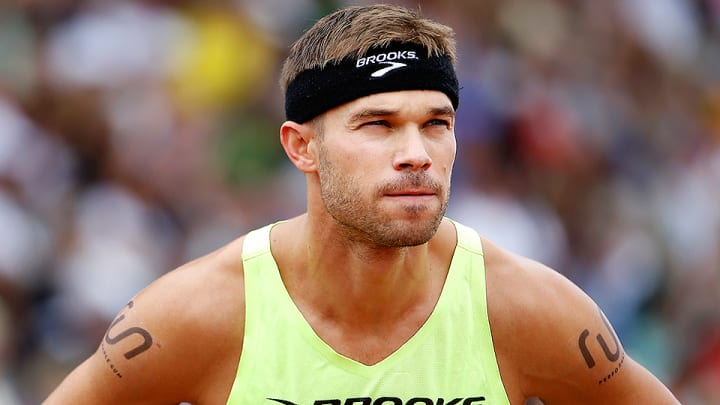Danny Mackey: It’s time to prepare mentally for Olympic Trials

Your teams. Your favorite writers. Wherever you want them. Personalize SI with our new App. Install on iOS (iOS or Android).
I am just now leaving the Stumptown Twilight track meet in Portland, Ore., a meet that gives athletes one final chance to either hit the Olympic standard or qualify for the Olympic Trials. At the meet, another coach came up to me and said, “Man, I hate these meets. Either athletes are really happy, or their careers are probably over.”
Those words sat with me for a while. This was just a last-chance qualifying meet; it doesn’t even compare to the Olympic Trials, where the stakes are so much higher. Years and years of tireless work comes down to one event on one day—a ruthless aspect of the sport. The NBA and MLB have best-of-five or -seven series, but when it comes to making Team USA, athletes get one chance.
The Olympic Trials are unlike any other track and field event. Athletes compete in front of 20,000 fans and on live TV, and they have to face the media immediately after the race. It’s hard to not think about it without getting anxious. So when the younger athletes talk about the trials I always try to bring their mindset to the present and give them perspective. If an athlete is not in the moment with their thoughts, I find that they’re either fearful because of what has happened to them in the past or anxious about what they think will happen to them in the future. Neither of those mindsets is optimal for performance because, as our sports physiologist Dr. Jim Bauman says, “your body can only be in the present, so that is where your brain needs to be.” So I try to focus their thoughts on what is going on right here and now.
• Bills WR Marquise Goodwin may be sacrificing NFL career for Olympics
In our last few days leading up to the Olympic Trials, I have the athletes intentionally focus on one day at a time. What’s on the slate for tomorrow? A seven-mile recovery run on the trails in Seattle. After tomorrow, the focus shifts to Saturday when they’ll run a four-mile tempo run. Then Sunday’s 12-mile run is super important. None of their thoughts have to do with the race at the moment because all that would be to them is noise and a distraction. Establishing this as a habit, the Beasts will be able to clear out all the noise and be in the moment when they are competing amidst all the pressure.
Olympic veteran Nick Symmonds understands the process, as he’s gone through it twice already. Before the 2008 trials, then-24-year-old Symmonds planned a vacation during the Beijing Olympics. That helped to clear his mind ahead of trials, knowing that his life wasn’t over if he didn’t make the team and giving him something to potentially look forward to if he did happen to struggle during the trials (he didn’t—Symmonds won the 800-meter final and clinched his spot to Beijing). Athletes can struggle with putting the Olympic Trials in perspective because many think that allowing themselves to think about 'life after trials' may come across as being too easy on themselves, but this approach frees up their consciousness so they are relaxed and able to execute with the utmost effectiveness.
I want nothing holding them back when the pain sets in during their races. They have to compete with nothing to lose. Katie Mackey likens it to her Stockholm Diamond League win last year. She tells the Beasts that we are all big time performers that show up when the stakes are high, even if we might be underdogs.
• Why did Nike want to sue Olympic hopeful Boris Berian?
It’s unbelievable how quickly the 42 months (since Jan. 2013) have gone, and it’s been a non-stop journey. The graduate student interning with the Beasts asked me, “What was the biggest learning curve for you since the Beasts started?” and I just sat there for a while. In theory, I should know more about mental preparation, programming, physio-therapy, recruiting, working with agents, dealing with the politics, ignoring the ugly stories about doping, maintaining hope, managing a budget and building an elite support team, but maybe not. Maybe I just have gotten lucky with the team’s success.
But if I am really pressed to answer, I think where I have grown the most as a coach is in my reckless abandon be in it right there with the athletes, for better or worse. If they succeed, I can physically feel the joy for them, if they fail, my stomach aches to the point where I want to puke. Track and field is so demanding, so raw, that I think for me to help give the athletes the best chance to be successful, I have to live it and be next to them on the path.
The entries are being finalized, but it looks like we will have 11 Beasts competing in Eugene. Each athlete has their own individual outcome they are striving for at the championships. A few of the rookie Beasts will be going for top-five finishes and the other six or seven Beasts will be racing to make the Olympic Team.
During the 2008 Olympic Trials, Nike had a cool marketing campaign called “The Hardest Team to Make.” That is 100% true. Being a U.S. Olympian for track and field is the equivalent of being a finalist for the MVP award in another sport, and I hope a Beast has that honor in two weeks. I know there are a few that are talented, prepared and have put in the work to be standing on the podium, but I also know there are only three spots for grabs, and another handful of athletes thinking the same thing. That is why they run the races.
